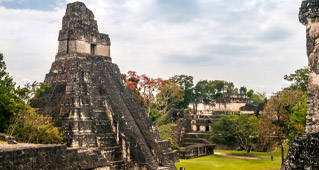Book NOW for $1 £1 €1 • Flexible Payments • No Change Fees • Private Departures Available
- Home >>
- Antigua City Guide
Antigua City Guide
Nestled amongst the highlands of central Guatemala is a quaint colonial city whose colourful cobbled streets act as a charming antithesis to the gigantic green volcanoes that sit on its doorstep. One of the best preserved colonial settlements in the whole of Latin America, along with the likes of Oaxaca and Cartagena, Antigua possesses a magical sense of historical significance and endearing charisma. Once a vital component of Spain’s rule in the continent, the city is now home to elegant museums, quirky restaurants and a creative arts scene befitting of its traditional textile heritage. Small in scale, it is explorable on foot, leading to an immersive cultural experience. Antigua is a city where life moves at an easy pace. One of the best things to do here is take a seat in one of the opulent squares and sip on a locally sourced coffee as the world drifts gracefully by.
Antigua’s Best Spots
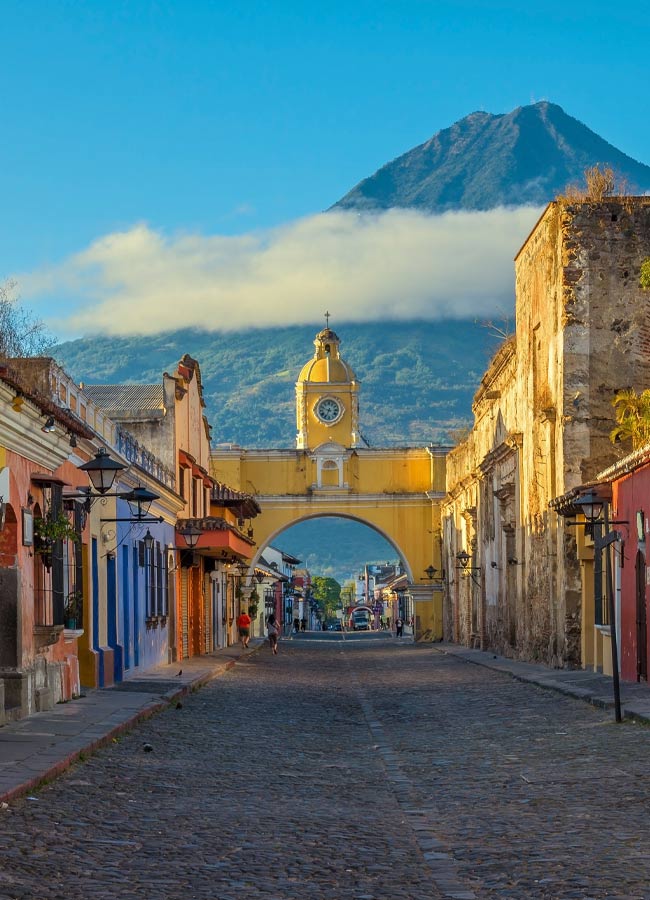
Being such a small city, most of Antigua’s top sights are all within a square kilometre at its core. The obvious place to start is Arco de Santa Catalina, which is often lauded as the most recognisable landmark in Guatemala. Originally built as a bridge between the city’s convent and a school so that nuns could pass from one to the other, the building is a picturesque amalgamation of an archway and a clocktower, elegantly framing the visage of Volcan de Agua from its northern side. The archway is actually the tip of the iceberg in terms of the baroque architecture to be admired. The grandiose Iglesia de La Merced shares the same canary-yellow tones as Arco de Santa Catalina and combines a sturdy structure with an intricately designed facade to a masterful degree. The equally impressive Iglesia de San Francisco trades vibrant colour for incredible detail, with a collection of marvellous carvings including statues of a number religiously significant figures looking over the church’s entrance. During Antigua’s famous Holy Week celebrations these churches become focal points for the festival.
Another beautiful example of Antigua’s spectacular architecture is Las Capuchinas, a convent with a number of atmospheric courtyards flanked on all sides by antiquated archways draped in vibrant local plant life. The grounds of the convent are a serene retreat from the streets that will inspire inner calm as you gaze at the centuries old structures. Those seeking an alternative spiritual experience should consider climbing Antigua’s Cerro de la Cruz. Even secular travellers will appreciate this giant cross’ hilltop location. The spot offers fantastic views over the city, with the colossal Volcan de Agua dominant skyline presence dwarfing the city. Many of Antigua’s greatest sights can be spotted when stood at this spot which gives a great impression of the overall urban aesthetic of its historic streets.
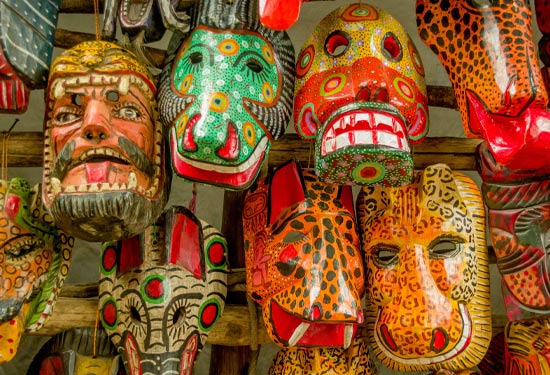

Amongst the city’s more popular museums are those dedicated to ancient art forms in the form of Museo del Libro Antiguo and Museo Casa del Tejido Antiguo. The former is a nod to the greatest works printed in Guatemala during the colonial nation’s period. Set within the walls of a beautiful traditional building facing the busy Parque Central, the relatively niche museum is rather enchanting and houses various famous works including a first edition of Don Quixote. Museo Casa del Tejido Antiguo is an establishment dedicated to traditional Guatemalan weaving. Found on the city’s outskirts, visitors will learn about the different types of weaving and will have the opportunity to buy some of the textiles produced on site.
For an alternative - and decidedly tastier - museum experience, visit Antigua’s Choco Museum. An institution dedicated to the art of chocolate making, in the very country of its origin, the museum even allows guests to try their hand at making their own chocolate and sample the sweet treat in the same drinkable form consumed by the Mayans.
One of the best ways to see Antigua is to explore the streets on foot, absorbing in the countless nuanced sights as you wander. Due to its history of natural disasters, the streets are strewn with a number of historical ruins that have amassed throughout the centuries. Their varied styles and derelict atmospheres make them well worth exploring - representing both a vivid step back into the country’s past and a physical symbol of the power of nature.
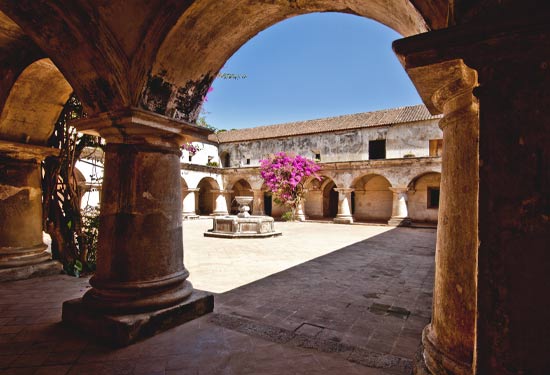
Trips that visit Antigua
Best of Belize and Guatemala
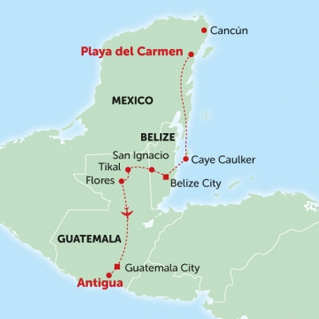
Duration:8 Days
Route:Playa del Carmen to Antigua
Tour Code:CPA
Mexico, Belize and Guatemala
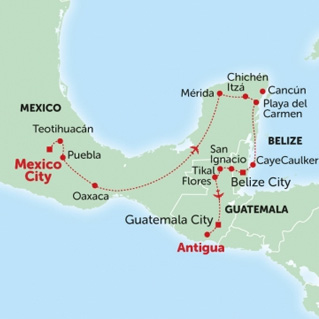
Duration:15 Days
Route:Mexico City to Antigua
Tour Code:CMA
Mexico to Costa Rica

Duration:28 Days
Route:Mexico City to San Jose
Tour Code:CMS
Food & Drink in Antigua
Like much of Latin America, international food is readily available throughout Antigua. However, if you wish to experience a more authentic side of the city it is imperative that you try some of the delicious local delicacies that are on offer from the city’s numerous restaurants, bars and market vendors. Fusing the ancient flavours of the Maya civilisation with a touch of European influence brought on by the Spanish settlers of the 16th century, Guatemala’s food scene is undoubtedly underappreciated across the globe.
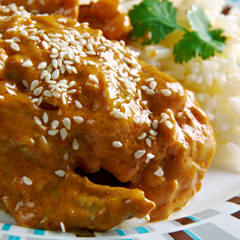
Pepian
When it comes to authentic local food, nothing could be more traditional than Guatemala’s national dish, pepian. Pepian is a filling stew containing meat - typically chicken or beef - that has been gradually simmered in a sauce made from vegetables, spices and a variety of ground nuts. The stew originates from the time of the Spanish conquest of Latin America, amalgamating traditional European and Mesoamerican flavours.

Jocon
Another stew-like Guatemalan favourite, jocon is bright green in appearance thanks to the base ingredients of tomatillos, coriander and green peppers. The sauce is often thickened with ground seeds and usually poured over chicken, which has seen various foodies compare it to the delicious traditional Mexican dish ‘mole’.
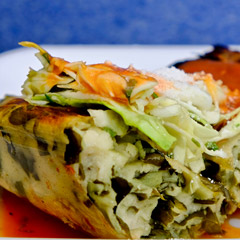
Tamales
A Latin American staple, this dish can be found from the southern tip of Patagonia to the very north of Mexico. Corn dough is filled with meat, beans, cheese, sauces or any combination of the above before being steamed in a corn husk. This makes for a soft snack that is perfect for eating on the go.

Pupusas
A thick flatbread that is sliced open before being filled with any number of fillings, typically cheese. These are then griddled until crispy on the outside but soft and tender in the middle. Pupusas are easy to find throughout Guatemala and are often served with sauces for dipping, adding to the already incredible flavours.

Kak’ik
A dish whose roots in Guatemala predate the Spanish conquest of the continent in the early 16th century. Kak’ik is a turkey-based stew whose sauce is made using tomatoes, coriander and a lot of chilli - which has earned kak’ik a reputation for its spicy flavouring. Often eaten during special occasions, it is very popular across the whole of Guatemala.
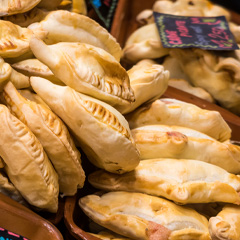
Empanadas
Another staple throughout South America and Central America, empanadas are filled pastries that are baked or fried and perfect for eating whilst on the move. Fillings can be anything from chorizo and beans to mushrooms and cheese but typically include slow cooked beef.

Coffee
One of Guatemala’s main exports, making them the third largest coffee producer in Central America after Honduras and Mexico. Thanks to this, there is no shortage of places in Antigua from which to buy your cup of piping hot expresso in the morning. Many of which boast quaint town square settings or incredible views of the surrounding volcanoes.

Chocolate
As Guatemala is the birthplace of chocolate, it stands to reason that the standard of the cacao products here is high. Go ultra-traditional and try chocolate in its most traditional liquid form or even follow the process - from bean to bar - to create your own chocolate at Antigua’s Choco Museum.
Getting around Antigua
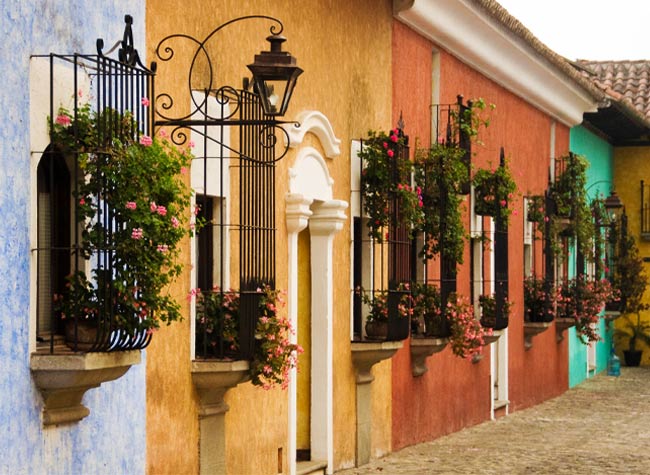
Given its diminutive size, most people opt to walk around the streets of Antigua. Most of the city’s main sights are within a couple of kilometres walk from each other, which also allows travellers to absorb every detail of their fantastic surroundings when on the move.
Those that don't wish to be on their feet all day could opt to catch a tuk tuk to their destination. Whizzing around the colonial streets in this quintessentially Latin American mode of transport can be good fun, but make sure that you agree a price beforehand in order to avoid being ripped off.
In terms of heading further afield, those that wish to immerse themselves in the local way of life should catch a chicken bus. These rickety, rainbow-coloured school buses are a perfect opportunity to observe the often chaotic lifestyle that faces Guatemalans from day to day. Crowded, hot and noisy, these buses may not be for everyone but it cannot be denied that a journey in a chicken bus is an experience to remember. Although typically safe, be wary of pickpockets when riding these buses.
Scooter rental is another option for those who wish to visit the surrounding countryside, but riders should always be careful if they're not experienced on a scooter. Wearing a helmet at all times is imperative.
Alternative things to do in and around Antigua
Sat in the centre of a tremendously historical country amongst gigantic conical volcanoes and emerald green jungle, the activity options surrounding Antigua are both varied and thrilling. The area surrounding Antigua offers travellers cultural enrichment and heart-pumping adventure, occasionally in unison, including Guatemala’s most recognisable natural landmark in the form of Lake Atitlan. Ancient ruins, colonial architecture and physical manifestations of overlapping cultures ensure that the nation’s multilayered history remains tangible for all who have the pleasure of visiting.
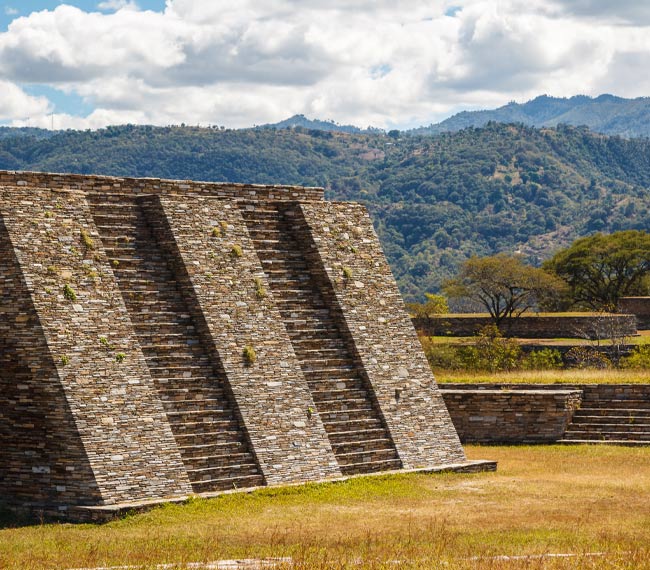
Exploring the tranquil ruins of Mixco Viejo
Roughly 60km north of Antigua lie the ruins of Mixco Viejo, the excellently preserved remains of an ancient Maya city. Whilst it may not be the largest Maya site in Guatemala, it more than makes up for it through the spectacular preservation of its pyramids and the fact that it often drifts under the radar of most travellers. Due to its relatively unknown status you may be lucky enough to find yourself exploring the ruins in total solitude.
Originally a fortress, the site contains 120 major structures made using thin slabs of rock - a feature that is unheard of in most Maya cities. Those that venture amongst the temples have the opportunity to climb the steps of the steep-sloped pyramids that were once reserved for royalty alone. The combination of geometrically precise stone buildings and impossibly flat lawns of grass make for an aesthetically pleasing experience that also demonstrates quite how skilled the Maya were in constructing such sites. Archaeological study of the site was hindered by the incorrect classification of the people that once ruled it, leading to much mystery shrouding its true origins. Structures found on the site include numerous temples and well preserved examples of Maya ball courts. The site was originally built to fend off enemies and withheld a month long siege from the Spanish during their invasion. Despite its violent history, it is now a place of tranquility and intrigue.
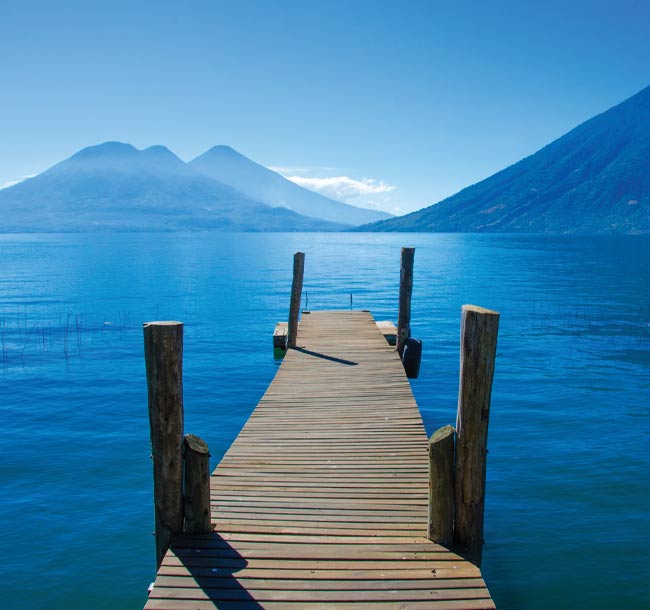
Gazing over the stunning vista of Lake Atitlan
Perhaps the most beautiful spot in the whole country, Lake Atitlan is a must for anyone who visits Antigua. The serenity of the placid lake combined with the powerful volcanoes lingering on the horizon creates a sense of awe and total immersion into the stunning natural scenery of rural Guatemala. 19km across at its widest point, the lake supports communities from the eleven towns and villages that sit on its shores. Thanks to the people that live within the vicinity of the lake, an abundance of activities have become available to visitors over the years. These vary from kayak rentals and lakeside yoga to hikes into the surrounding hills, such us La Nariz, for spectacular views of the surrounding landscape. Travellers may also wish to gain the full Lake Atitlan experience by taking a dip in the peaceful blue waters, but make sure not to swim in the lake’s more polluted spots to avoid an upset stomach.
Aside from the lake itself, the towns that surround it can be very charming and varied in the attractions that they offer. San Pedro is renowned for its backpacker friendly nightlife, Solola has a traditional feel with an enticing local market and Jaibalito doesn't have much going on but therein lies the charm - it is the perfect escape from the crowds. One absolute must for those on the eastern shores of the lake is to watch the sun setting below the horizon as it paints the waters all manner of different rose and apricot shades. Best enjoyed with a cold drink in hand. Those that wish to do something different can scuba dive in the lake, searching for sunken buildings and old relics lost to the water.
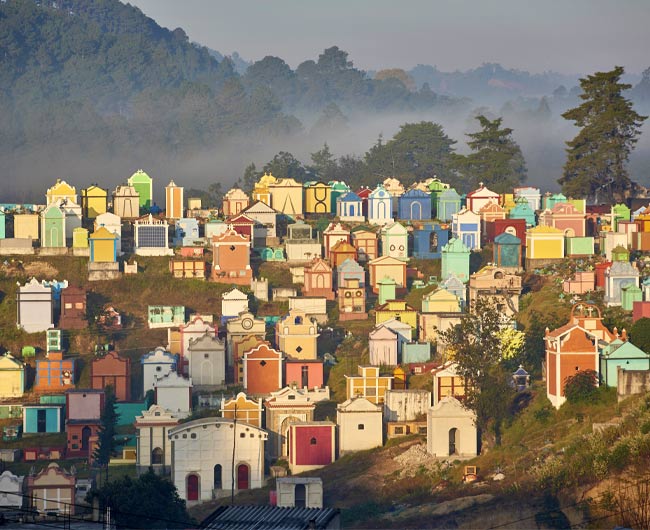
Visiting the colourful Chichicastenango Cemetery
This cemetery to the north of Lake Atitlan is a physical manifestation of Christian and Mesoamerican traditions merging into one in the form of a colourful collection of tombstones. The hillside above the town of Chichicastenango is rife with peaceful crucifixes and shrines painted, true to Latin _, in every imaginable colour. The origins of the colourful burial sites spring from the Maya associations between colours and what they represent. For example, white represents purity whilst turquoise represents protection. This how evolved over time to see graves painted the favourite colour of those buried within.
Locals frequent the exuberant cemetery with gifts for the deceased - a ritual that intensifies during the famous Day of the Dead festival celebrated in Central America. Local beliefs maintain that deceased loved ones linger in the afterlife and communicate with the living through the channel of dreams. If the burial is incorrect then this connection can be severed. Guatemalans therefore ensure a proper burial in every way possible - a belief that has manifested itself in the form of this vibrant burial site. The cemetery is an excellent physical representation of a unique culture that has drawn on the influence of those that once ruled this land.
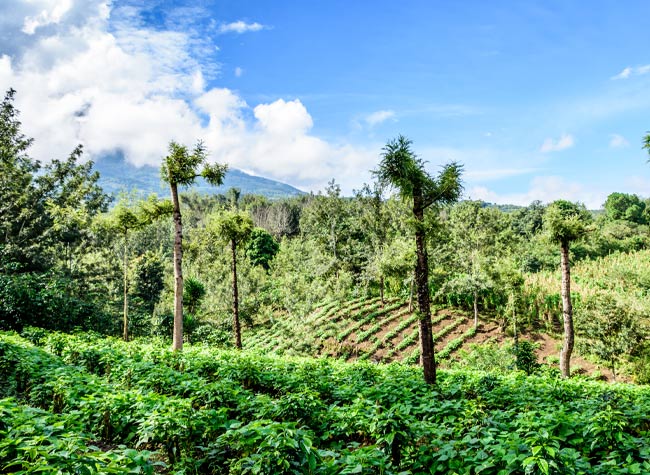
Learning about coffee production on a farm tour
A visit to Antigua is an excellent chance to discover more about one of the planet’s most popular hot drinks. In the slopes surrounding the colonial city are a number of coffee farms that run tours around their complexes, teaching visitors about the process of making coffee from growing the bean to pouring of the cafetiere. Travellers will typically venture between the coffee plants through the rich green canopy of the farm, which can be breathtakingly beautiful, as they are walked through the process. It is a great insight into one of the most important components of modern Guatemalan culture.
Many of the coffee estates have been converted into luxurious establishments set within the walls of traditional structures that have stood for centuries. Even if you aren't a fan of coffee, the estates offer stunning views and activities such as bike rides, bird watching, hiking and even paintballing. Escaping into Antigua’s surrounding hillsides immerses travellers into an alternative side of rural Guatemalan life and boasts some of the most incredibly luscious highland views that the country has to offer.
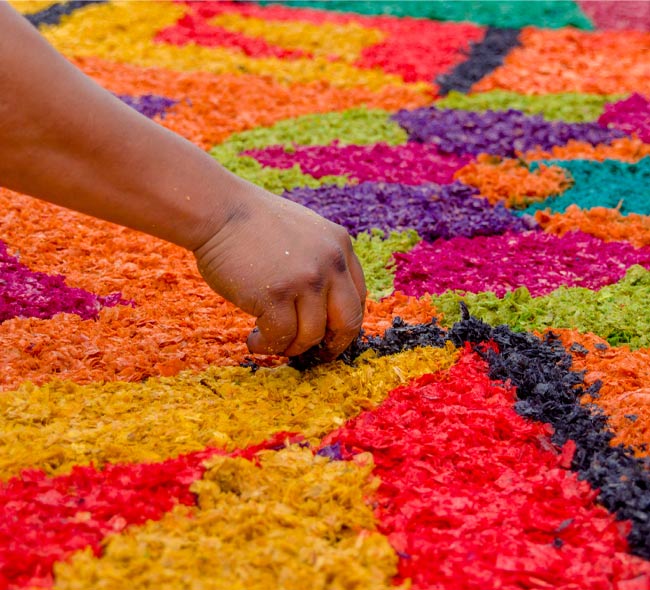
Celebrating at one of the nation’s annual festivals
Antigua is an excellent place from which to enjoy Guatemala’s traditional annual celebrations, some with unique twists of their own. The most flamboyant yearly celebration comes in the form of the Semana Santa Easter festival. Each Easter sees the quiet town explode into colourful festivities, with locals dressed in traditional purple robes, carrying colossal Biblical-themed floats and decorating the city streets with remarkably elaborate carpets of petals and sawdust. The festivities draw revellers from across the globe who wish to witness the _ spectacle and appreciate the deep spirituality that resonates throughout Antigua as a whole.
Day of the Dead has gained international renown for the energetic street parties and zestful outfits of Mexico’s local population. In Guatemala, similar traditions are followed but in a more sedated, family-focussed manner. Rather than throwing all night parties, locals in Guatemala tend to pay their respects by cleaning or painting the graves of their loved ones before offering gifts and enjoying cemetery picnics with fellow locals, culminating in mass celebrations of ancestral respect. On All Saints Day the highlight of the Day of the Dead festival occurs in Antigua in the form of hundreds of kites being flown. Antiguan citizens believe that kites are a way to notify the spirits of their ancestors in the heavens of their location, so that they can find their way home. The kite festival has developed over the years and now includes giant and elaborate designs that fill the sky in a colourful and joyous occasion.
Guatemala Tailor-made Holidays
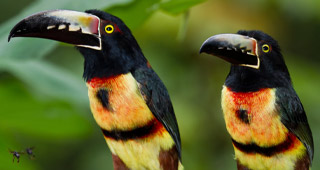
Guatemala Encompassed
Duration:14 Days
Route:Guatemala City to Guatemala City
Tour Code:TMGE
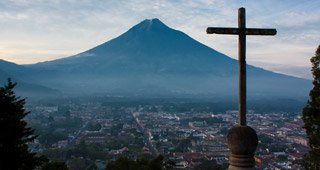
Wonders of Guatemala, Honduras & Belize
Duration:19 Days
Route:Guatemala City to Belize City
Tour Code:TMGHB
Guatemala Blogs
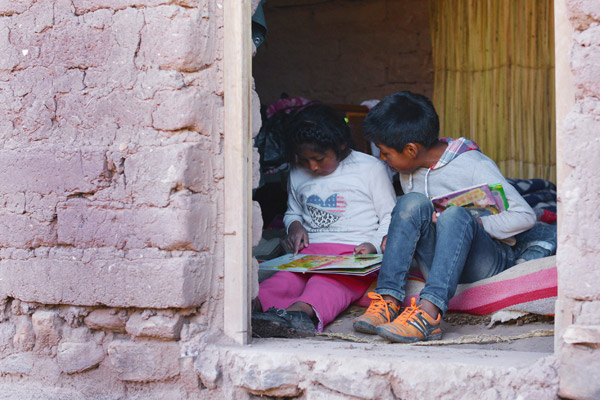
Exploring Mulitlingualism in Latin America for International Literacy Day
International Literacy Day is an annual opportunity for Governments and civil society to highlight improvements in world literacy rates and come together to reflect on ongoing literacy challenges.
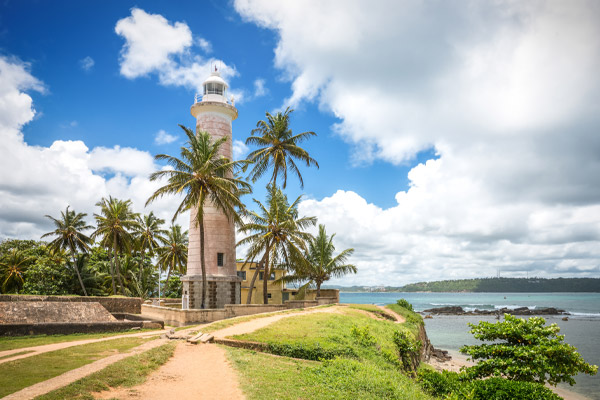
Top Alternative Cities
If you are a city person and a traveller, you probably already have more than a few of the world’s capitals ticked off. There’s just as much to discover in cities that often aren’t under the spotlight. Here’s our list of our top alternative cities.



